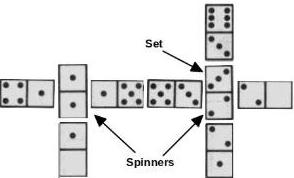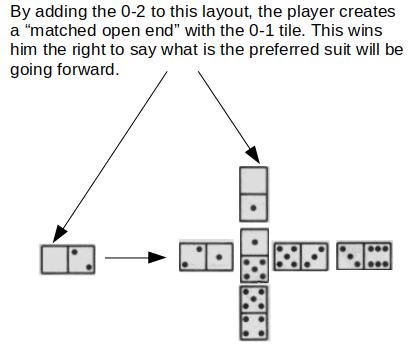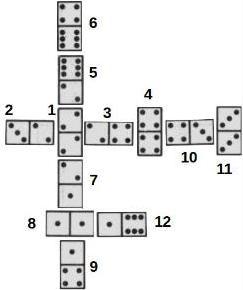39
Invented by Howard Fosdick © BestFreeNewGames.com
Overview: A fine game that especially appeals to those who like to disrupt their opponent's play.
Players and Equipment: 2 players use a set of 6-6 dominoes.
Objective: Win the hand (or deal) by scoring more points than your opponent. Win the Game by winning the most total points across 5 hands.
Start: All tiles are placed face down and shuffled. Each player takes 5 tiles for his hand. Remaining dominoes become the drawing stock or boneyard.
The Set: Determine who goes first by drawing a tile or flipping a coin. In subsequent hands, the loser of the prior hand chooses who goes first.
The firstplayer lays any tile from his hand face up as the foundation tile or set. Lay the set vertically between the two players. Then it's his opponent's turn.
Play: In his turn, a player plays one tile to the layout. One end of the tile he plays must connect to and match the open end of a tile already in the layout.
A player must play a tile if he has one that is playable.
If he has no playable tile, he must draw from the boneyard until he gets one. He must play the first playable tile he draws.
To end his hand, a player ensures he has at least 5 tiles in his hand. If necessary, he draws a tile from the boneyard to get back up to 5 tiles.
The Layout: This example illustrates the rules for building a layout:

The first tile played (the set) was the 3-2 tile. Players may connect tiles in 4 directions from the set.
In this example with a 3-2 set, two of the connecting tiles must connect via a 2 spot, and the other two tiles must connect via a 3 spot. There are no other requirements or restrictions about playing tiles off the set.
The 1-1 tile shows that doublets are always laid crosswise to their line of play. Each doublet may be played off of in 4 directions, just like the set. Tiles playable in 4 directions -- the set and all doublets -- are called spinners.
Note that since 3 tiles have been played against the 1-1, that 1-1 tile still offers one more open end that can be played off.
Should playing a tile to the layout cause a physical collision with existing tiles in the layout, that play is not permitted. (You cannot arbitrarily change the direction of play as in some domino games.)
Preferred and Penalty Suits: Two suits exist during play: the preferred suit and the penalty suit.
At any one time, the preferred suit is either Even or Odd. The penalty suit is the other suit.
Even corresponds to the dominoes leaving even-numbered open ends (0, 2, 4, and 6), whilst Odd refers to tiles leaving odd-numbered open ends (1, 3, 5).
The significance of the preferred suit is in scoring -- which will be explained below.
The initial preferred suit for the hand is established by totalling the pips of the set. If the set is the 3-2 tile, for example, the initial preferred suit is Odd because the total number of pips on that set is an odd number. The penalty suit is therefore Even.
Changing the Preferred and Penalty Suits: When a player plays a tile that matches an existing open end in the layout, he wins the right to immediately declare the preferred suit. He may either change it or leave it the same.
Here's an example of matching an open end:

Matching open ends with the set does not count -- it does not enable a player to change the preferred suit.
Scoring: The significance of the preferred suit is in scoring.
- Playing a doublet of the preferred suit scores points equivalent to the doublet's suit. For example, playing the 5-5 when the preferred suit is Odd scores 5 points.
- Playing a doublet of the penalty suit scores 0 points.
- Playing a singlet that leaves an open end of the preferred suit scores 0 points.
- Playing a singlet that leaves an open end of the penalty suit scores -1 point.
- Playing a singlet that leaves an open end of the penalty suit -- but that also creates an open end match - scores 0 points.
- Playing the 0-0 tile (the blank-blank domino) in the preferred suit scores the same number of points as the last scoring doublet. If played prior to any scoring doublet, or if played in the penalty suit, it scores 0 points.
The Set: Playing the set never scores points.
Matching the set's open ends does not qualify for changing the preferred suit. Nor does it protect a singlet played in the penalty suit from scoring -1 point.
End of Hand: If a player does not have a playable tile in hand, he must draw from the boneyard until he gets one. He must immediately play the first playable tile he draws.
If he doesn't draw a playable tile or the boneyard is exhausted, the player must say "pass".
A hand ends when either one player has no dominoes (and there is no boneyard to draw from), or when both players say "pass" back to back.
Final Scoring: As well as scoring via doublets during the hand, scoring occurs and the end of the hand.
If a player ends the hand by going out of tiles (he dominoes), he receives 1 point for each singlet domino in his opponent's hand.
He also scores for each doublet in his opponent's hand as if he had scored in the preferred suit for that doublet (for example, the 5-5 scores 5 points, the 2-2 scores 2 points, etc).
The 0-0 tile is equal in points to the last doublet played to the layout (regardless of whether that last doublet scored points).
-----------------------------------
Example Play:

Play #1 - The set of the 2-2 establishes Even as the preferred
suit, since the total of the set's pips is an even number. Playing the
set never scores any points. The player ends his turn by drawing a
tile, to take his hand back up to 5 dominoes for his next turn.
Play #2 - The opponent has no tile that will result in an even-numbered open end, so he is forced to play his 2-3. The open end is 3,which is in the penalty suit of Odd, so this tile scores -1 point.
Play #3 - Playing the 2-4 singlet results in an open end in the preferred suit of Even, so this scores 0 points.
Play #4 - The even 4-4 doublet is played in the preferred suit of Even, so it scores 4 points.
Play #5 - Playing the 2-6 results in an open end in the preferred suit of Even, so this scores 0 points.
Play #6 - Playing the 6-4 matches an open end of the 4-4 tile. This means that the 6-4 scores 0 points, regardless of whether or not its open end is in the preferred suit. The open end match entitles the player to dictate the preferred suit. In this case the player changes the preferred suit to Odd.
Play #7 - Playing the 2-1 singlet results in an open end in the preferred suit of Odd, so this scores 0 points.
Play #8 - The odd 1-1 doublet is played in the preferred suit of Odd, so it scores 1 point.
Play #9 - The player lays the singlet 1-4 tile. Although this creates an open end in the penalty suit, it scores 0 points, because it creates an open end match with the 6-4 tile (and the 4-4 tile as well, for that matter). This allows the player to dictate the preferred suit. He chooses to change the preferred suit to Even.
Play #10 - Playing the 4-3 singlet results in an open end match with the 2-3 tile. So this scores 0 points, even though the open end it creates is in the penalty suit. The player elects to change the preferred suit to Odd.
Play #11 - The odd 3-3 doublet is played in the preferred suit of Odd, so this scores 3 points. It also matches the open end of the 2-3 tile, so the player can change the preferred suit if he desires. This player elects to leave it as Odd.
Play #12 - The player lays the singlet 1-6 tile, which creates an Even open end, so this tile scores -1 point. This play shows how all doublets are spinners and can be played off of in all 4 directions. Each unused open end on a doublet is available for both playing connecting tiles and for matching open ends. Note that players often have choices where to place tiles. For example, the player could also have laid the 1-6 tile to the other side of the 1-1, had he so chosen.
As we conclude this example, it may be useful to summarise the
existing open ends of the final layout:Play #2 - The opponent has no tile that will result in an even-numbered open end, so he is forced to play his 2-3. The open end is 3,which is in the penalty suit of Odd, so this tile scores -1 point.
Play #3 - Playing the 2-4 singlet results in an open end in the preferred suit of Even, so this scores 0 points.
Play #4 - The even 4-4 doublet is played in the preferred suit of Even, so it scores 4 points.
Play #5 - Playing the 2-6 results in an open end in the preferred suit of Even, so this scores 0 points.
Play #6 - Playing the 6-4 matches an open end of the 4-4 tile. This means that the 6-4 scores 0 points, regardless of whether or not its open end is in the preferred suit. The open end match entitles the player to dictate the preferred suit. In this case the player changes the preferred suit to Odd.
Play #7 - Playing the 2-1 singlet results in an open end in the preferred suit of Odd, so this scores 0 points.
Play #8 - The odd 1-1 doublet is played in the preferred suit of Odd, so it scores 1 point.
Play #9 - The player lays the singlet 1-4 tile. Although this creates an open end in the penalty suit, it scores 0 points, because it creates an open end match with the 6-4 tile (and the 4-4 tile as well, for that matter). This allows the player to dictate the preferred suit. He chooses to change the preferred suit to Even.
Play #10 - Playing the 4-3 singlet results in an open end match with the 2-3 tile. So this scores 0 points, even though the open end it creates is in the penalty suit. The player elects to change the preferred suit to Odd.
Play #11 - The odd 3-3 doublet is played in the preferred suit of Odd, so this scores 3 points. It also matches the open end of the 2-3 tile, so the player can change the preferred suit if he desires. This player elects to leave it as Odd.
Play #12 - The player lays the singlet 1-6 tile, which creates an Even open end, so this tile scores -1 point. This play shows how all doublets are spinners and can be played off of in all 4 directions. Each unused open end on a doublet is available for both playing connecting tiles and for matching open ends. Note that players often have choices where to place tiles. For example, the player could also have laid the 1-6 tile to the other side of the 1-1, had he so chosen.
3 (off the 3-2 and the 3-3 doublet), 4 (off the 6-4, the 4-4 doublet, and the 1-4), 1 (off the 1-1 doublet), and 6 (off the 1-6).
All these open ends are available to play tiles off of in the layout, and also for the purpose of matching open ends.
-----------------------------------
Tips for Play: Since the preferred and penalty suits often change, some players place a coin on the board to keep track of which suit is currently preferred, and which is currently the penalty suit. A face-up coin shows that Even is the preferred suit, while face down means Odd is preferred. Flip the coin whenever you change the preferred suit.
Only doublets score points, so manipulate the preferred suit to advantage so that you score them... and so that your opponent does not.
Optimise score for the 0-0 by playing it in the Even suit after a recent high-scoring domino.
Try to avoid playing singlets that create an open end of the penalty suit, as these score -1 point.
If it looks like your opponent might soon go out, you can dump a doublet in the penalty suit to avoid being caught with it, scoring 0 points. Otherwise your opponent might score for your doublet when he goes out.
Defensive play is critical. Flip the preferred suit to disrupt your opponent's scoring efforts, and force his plays into the penalty suit by leaving him unfavourable open ends.
-----------------------------------
License: Feel free to print, copy, and distribute these rules, so long as you retain this paragraph. Invented by Howard Fosdick © 2023, distributed under Creative Commons License CC BY-NC-ND. HOME